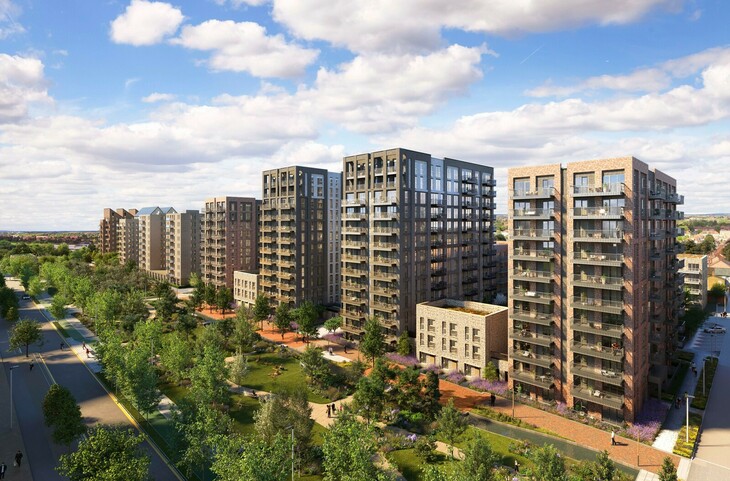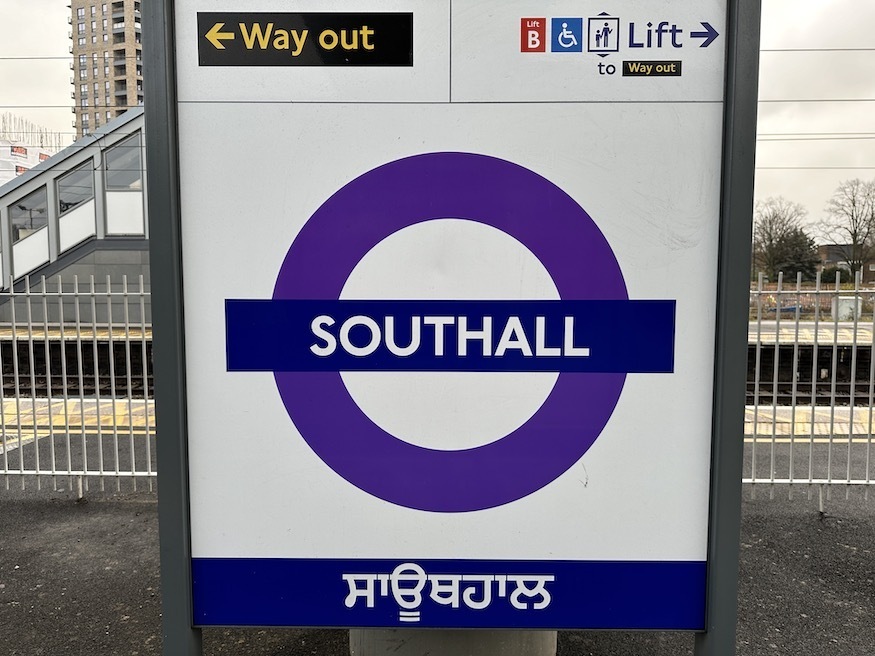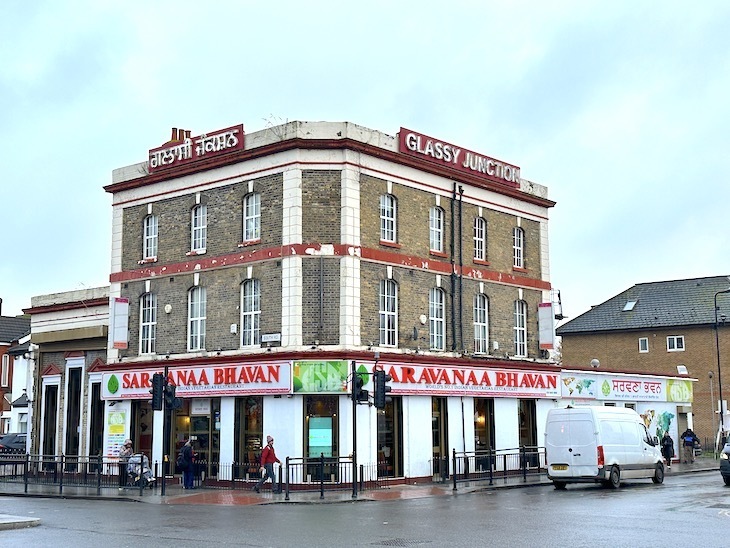The arrival of the Elizabeth line has put many outer London neighbourhoods on the map. Southall, of course, has long been recognised as a thriving hub of South Asian culture, with hundreds of independent shops and restaurants. But now it's on the tube map, it's luring many Londoners who might not have visited before. The town is just five stops out of Paddington on the Elizabeth line, or two stops if you catch the fast service. You'll be there in a jiffy, and there's plenty to see...

1. North Vs South
In case you were wondering where the name comes from, Southall is first recorded as Suhaull in the late 12th century. Its original meaning was something like "southern corner", as in the corner of a piece of land or a wood. Nearby Northolt is its opposite, with a name that derives from "northern corner".
Now, here's the confusing bit. The most southerly part of Southall is called Norwood Green, implying a northern wood (and not to be confused with Norwood in south London). Got that?
2. The ye olde bits
Much of Southall was developed from the 19th century, but it also has a few pockets of olden days charm. Just south of the Elizabeth line station can be found Southall Manor House, a much-altered yet still remarkable survivor from the Elizabethan era. The manor's former grounds are now a public park and contain several ancient yews (that's one poking into the foreground in the photo at the top). Still further south, in the aforementioned Norwood Green, stands a handsome 17th century pub, the thatch-roofed Plough. It's older than just about any drinking den you'll find in central London, and is Grade II listed.
3. Wharncliffe Viaduct

One of London's engineering marvels stands to the east of the wider Southall area, closer to Hanwell. Wharncliffe Viaduct has spanned the Brent valley here since 1836, when Isambard Kingdom Brunel oversaw its construction to help the Great Western Railway get in and out of London. Legend has it that Queen Victoria would ask for the Royal Train to pause on top, so she could admire the views. Today, the land below is a sprawling country park, where you can follow the River Brent as it meanders its way through wild meadows. Look out for bats; the viaduct houses a sizeable colony. And while you're in the area, you can see many more animals at Hanwell Zoo. There's a maze nearby, too.
4. Three Bridges

That's not the only Brunellian wonder in the area. A little way to the south, can be found a canal sandwich. In one of his final projects, Brunel orchestrated the significant engineering challenge of taking a railway branch line underneath the canal, while also projecting a road (Windmill Lane) over the top. The triple point of transport modes is known as Three Bridges. If the adjacent Ealing Hospital ever decides to start an air ambulance service, they should build the helipad right here, to add a fourth layer to the mix.
5. Spreads, sausages and Sugar Puffs
If you walk the streets of Southall today, you're likely to encounter all kinds of delicious aromas from the mix of independent restaurants. Turns out the area has previous when it comes to food. Southall was once home to the Maypole Dairy, operated by Otto Monstead. The factory was one of the largest margarine producers in the world and, at its peak, spread over an area larger than St James's Park. It was later acquired by Unilever and turned to meat processing. If you ate a Wall's banger in the 1980s, chances are it passed through Southall. Another childhood icon, the Honey Monster, also calls Southall home. Sugar Puffs were invented at the Quaker Oats Mill in Southall in the 1950s and produced here for many years.
6. London's most handsome water tower?

Look at this beauty. It's a former water tower, constructed at the end of the 19th century to provide water for steam locomotives. Its crenelated form was supposedly suggested by Queen Victoria (that's twice she's popped up in Southall), who was not amused by more industrial designs. After the steam age, the building lay derelict for some time before conversion into flats. Until recently, it was accompanied by an old, disused gasometer. This was famous for displaying a giant arrow on its side, pointing pilots in the right directions for Heathrow Airport (the nearby airfield at Northolt apparently caused some confusion).
This is a sponsored inclusion on behalf of The Green Quarter.
An exciting new regeneration project with health and wellness at its heart

By now, you’ve familiarised yourself with Southall's rich history — but what about its future? Exciting changes are afoot, with the development of The Green Quarter. This regeneration project is bringing new homes, community spaces, retail and leisure facilities, and vast green space and parks to Southall. It's designed with health and wellness in mind, and The Green Quarter's latest phase — Quadrant House — is no exception.
Quadrant House is a superb collection of Manhattan, one, two, and three bedroom homes, overlooking the development's 4.5km-long central gardens. The building itself benefits from private podium gardens, as well as spacious balconies and elevated interiors that reference the natural world — think calming, earthy tones, soft finishes, and timber effect flooring. The building's communal lobby area is similarly well designed, providing soft seating, meeting rooms and break-out spaces for residents, to work, sit and read, or wait for friends.
At Quadrant House, you're mere moments from a ton of top tier amenities. These include The Parkside Club, with its gym and spaces to unwind. There's also Parkside Yards — home to a ceramics studio, a tree nursery and community centre with a lively events programme. And when you do want to venture further afield, know that you're only 13 minutes from London Paddington on the Elizabeth line. How convenient is that?!
Quadrant House launches in 2025. In the meantime you can book a tour of its show home, and check out the development as a whole here.
7. The bilingual Elizabeth line

Southall has one of the most diverse communities in London. The first hint appears as soon as you step onto the Elizabeth line platforms. This is one of only a tiny number of London stations to have bilingual signage, and the only one to include another language on a roundel sign. The writing at the bottom is in Gurmukhi script, commonly used by Sikhs.
8. A genuinely multicultural centre

Southall really does blend cultures like few other places in London. It's home to the largest Punjabi community outside the Indian Subcontinent, as well as London's largest Sikh community. The mix really comes out in the streets. Right next to the station is the former "Glassy Junction", once a Punjabi pub but now a vegetarian Indian restaurant. Nearby, an old double decker bus has been converted into a Halal takeaway. The King's Hall Methodist Church advertises services in Urdu, Hindi, English, Gujarati, Punjabi and Chinese. You'll find further examples all over the area, including Southall Market which, back in 2018, we described as one of London's last 'proper' markets.
9. London's largest Sikh temple

This is the Gurdwara Sri Guru Singh Sabha, to the south of Southall. Constructed between 2000 and 2003 it's the largest Sikh temple in London and, indeed, in Europe. It's very well known locally, towering over the surrounding estates, but deserves to be placed among London's most famous buildings. Perhaps the most remarkable aspect of this vast building is that it was entirely funded by contributions from the local community. The mostly Sikh donors raised £17 million (around £30 million today) to see it built. Southall contains many other architecturally interesting gurdwaras and other religious buildings.
10. Movie history
Most people have heard of Ealing Studios but Southall, a little way down the rail track, played its own part in British film history. Southall Studios operated between 1924 and 1958, producing dozens of films and occasional TV programmes, including Boris Karloff's Colonel March of the Yard. Joan Sims and Christopher Lee were among the stars to perform here. In more recent years, Bend it Like Beckham (2002) was partly set and filmed in Southall, while several Bollywood movies have also been shot here.
Southall, West London is easily reached by Elizabeth line, just 14 minutes from Paddington.
x


